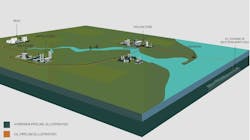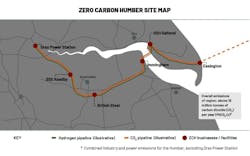Humber emissions capture project targets sub-North Sea storage
Offshore staff
STAVANGER, Norway – A group of 11 companies, including Equinor, have submitted a joint proposal to create a low carbon cluster in the Humber river region on the English east coast.
This is said to be the UK’s largest and most carbon-intensive industrial region.
The Zero Carbon Humber (ZCH) Partnership aims to establish the world’s first net zero industrial cluster by 2040, also supporting clean industrial growth in the area, and would involve permanent storage of captured emissions beneath the southern North Sea.
ZCH has applied for Phase Two funding from the UK government’s Industrial Strategy Challenge Fund, having successfully bid for Phase One funding (announced in April).
Others in the partnership are Associated British Ports, British Steel, Centrica Storage, Drax Group, Mitsubishi, National Grid Ventures, px Group, SSE Thermal, Saltend Cogeneration Company, Uniper, and the University of Sheffield’s Advanced Manufacturing Centre.
One part of the bid is the Equinor-led H2H Saltend (Hydrogen to Humber Saltend) hydrogen project at Saltend Chemicals Park near Hull.
This would convert natural gas to hydrogen, combining a 600-MWt autothermal reformer with carbon capture. From the start of operations, H2H Saltend would cut industrial emissions by nearly 900,000 metric tons/yr, (992,080 tons), the partners claim.
A second element is the hydrogen and carbon dioxide (CO2) pipeline network developed by National Grid Ventures which would link H2H Saltend to other industrial sites in the Humber region, which could then switch fuel to hydrogen or have their emissions captured.
These sites include the Drax power station, SSE Thermal’s Keadby site, Uniper’s Killingholme site, and British Steel at Scunthorpe.
CO2 emissions would be transported by pipeline to Easington on the Yorkshire coast and then offshore for subsurface storage.
A consortium of companies including Equinor is working on developing the offshore transport and storage infrastructure.
This network would be shared with the Teesside industrial cluster, where Equinor is also a partner in the Net Zero Teesside decarbonization project.
ZCH’s proposal costs £75 million ($97 million), to be provided by a combination of private and public funding. Funds would help progress the program toward a final investment decision in 2023, with H2H Saltend and the associated infrastructure potentially coming onstream in 2026.
10/08/2020

